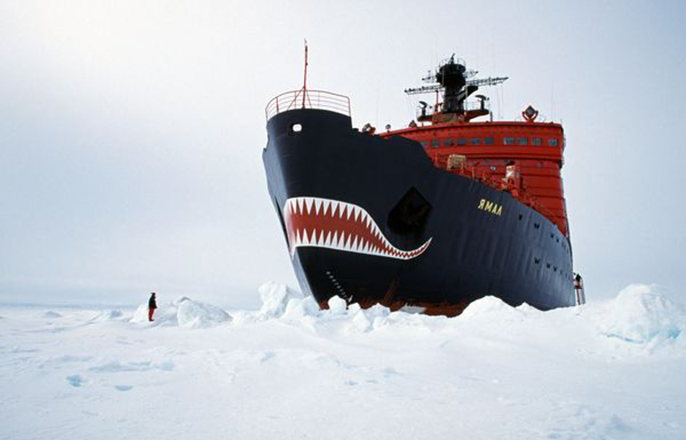
During a meeting of the Arctic Council in Fairbanks, Alaska, Sergey Lavrov reassured everyone: “There is no potential for conflict in the Arctic,” he said. The day before, however, Moscow had set up the Arctic Forces for the first time on the Red Square, with Tor and Pantsir missile systems in white-gray camouflage.
And a few days later, Rosneft announced the discover of the largest oil field ever to the Pole, in the Laptev Sea.
How can we put these elements together?
Arm the Arctic
At least since 2011, the Russian Defense Ministry is working on a decisive militarization of the Arctic with unprecedented levels. Large-scale exercises, proclamations, and frequent contacts between the NATO and Russian air force at the limits(and beyond) of the North American airspace are testing Western cohesion.
Putin has launched a multi-year program to restore numerous military bases in the Russian North. Only in the first year, 10 air bases abandoned since the times of USSR, were resumed. Moscow today can already count on 15 bases in the far north. Including the brand new Nagurskoye base, on the Franz-Josef Land, the northernmost one. An investment of $ 130 million alone.
And above all, the new command of the Arctic, the super-military district that brings together all the forces of air, earth and sea beyond the Polar Circle.
It’s hard to deny that there is enough to keep eyes open. How to forget the words of General General Philip Breedlove, former Supreme Commander of Allied Forces in Europe? “Allies are very concerned about the Russian militarization of the Arctic,” he said during a hearing last year. “What we saw in Crimea first and then in Donbass, and what we are seeing right now in Syria, is the design of Russia to first put the military forces in the field to put their own conditions and negotiate from a position of power” .
Because there is no need for an armed conflict to represent a threat.
War at the North Pole
Lavrov’s recent words, also used for a long article on the Moscow Times aimed at eliminating any fear of an Arctic conflict, are not enough. They are not enough to drive out the fear of Russian resurgence nor to push NATO to ignore the threat.
Breedlove’s analysis could someday be prophesied. Because, while the Kremlin fills the Pack with missiles,
it also sends its experts to the Commission the limits of the UN continental platform to have itsthe claims on the Polar Plaque, the largest natural resources field still untapped.
It is no coincidence that in the weeks when it annexed the Crimea without firing a single shot, Russia also marked another conquest at other latitudes. The UN commission on the limits of the continental plaque has recognized Moscow’s right over an area of 52,000 square kilometers in the Okhotsk Sea off the Kamchatka.
“It is only the beginning of our claims on the Arctic,” said then the Minister of Natural Resources and Environment.
There’s enough to get the radars on.
Mecca of gas and oil
The recent discovery of Rosneft merely confirms the Russians put theit eyes on the offshore oil fields at the Pole.
Dmitry Rogozin, the Russian Deputy Prime Minister’s, twitted that “Arctic is the Russian Mecca.”
According to scholars, the Arctic shell has fallen by 40 percent in the last twenty years and is destined to disappear within a dozen years . Drilling where now there is ice will no longer be impossible. The Arctic prepares to be a tough battlefield between Russia and the other Arctic countries, the United States and Canada in first place. The polar ice that is melting is about to release an immense wealth in terms of gas and oil: Reserves estimated in 10-15% of all oil and even in 30% of all the gas not yet uncovered make Arctic the largest field of unused natural resources. The state giant Gazprom has invested billions of dollars in prospecting and exploitation projects so far. Its flagship, worth alone $ 6 billion, is the Prirazlomnaja project, the giant marine platform of Greenpeace 2013.
From Ukraine to Syria, Putin has shown us that he loves to sit at the tables of international negotiations when his army is already well-placed in the field. The other Northern coinuntries shouldn’t be unprepared.
@daniloeliatweet
During a meeting of the Arctic Council in Fairbanks, Alaska, Sergey Lavrov reassured everyone: “There is no potential for conflict in the Arctic,” he said. The day before, however, Moscow had set up the Arctic Forces for the first time on the Red Square, with Tor and Pantsir missile systems in white-gray camouflage.






